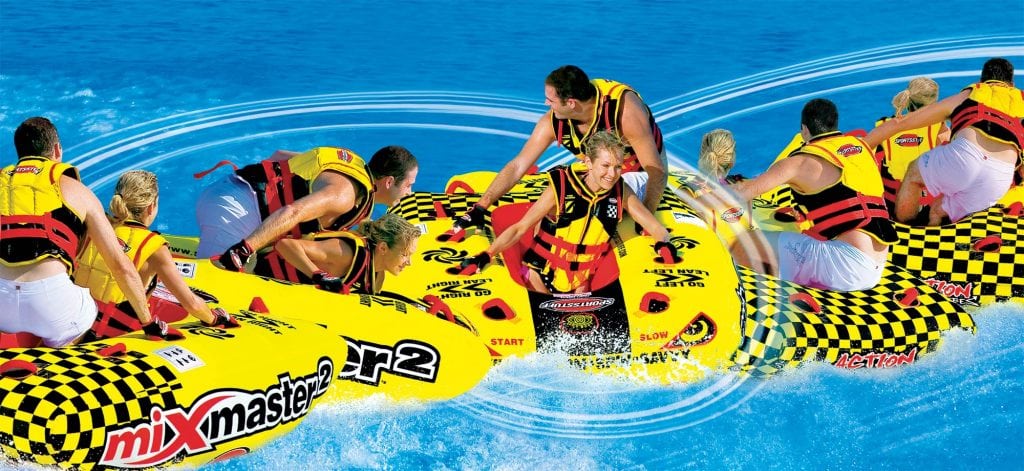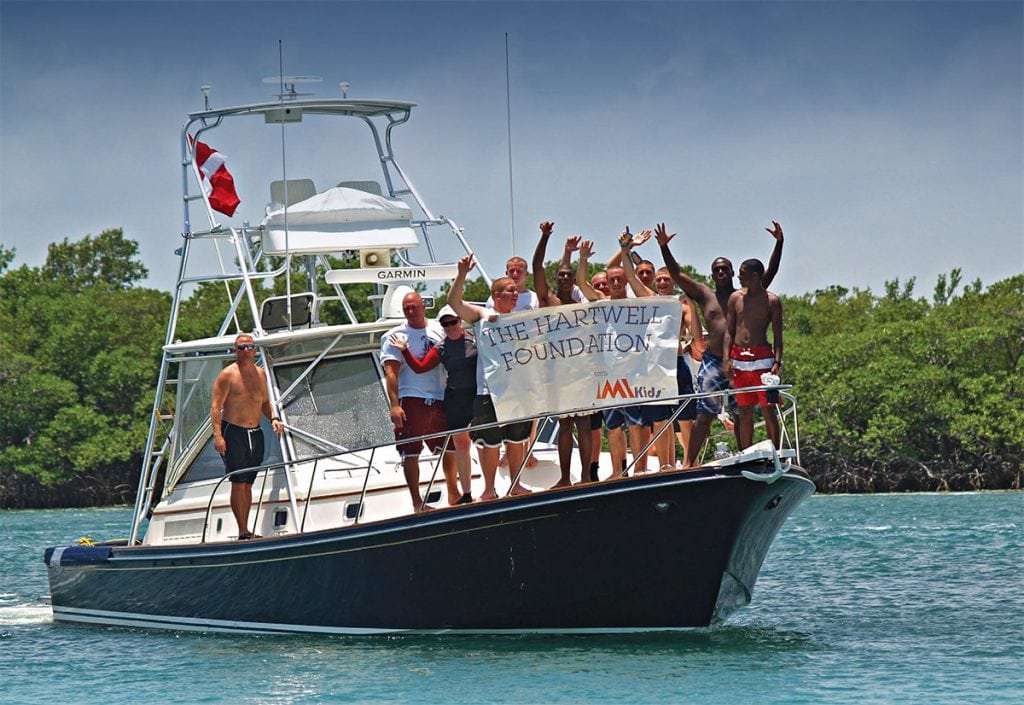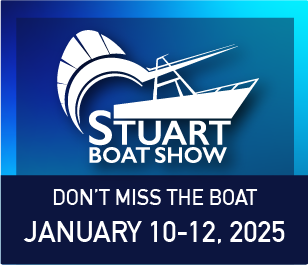Guarantee your family’s fun with the right water toys and accessories.
My friend with perfectly coiffed hair expected a leisurely water tube ride and thought her golden locks would stay dry. The three-person tube was huge, and she figured as long as the speeds were low, she was safe. The trouble was it was her brother’s boat, her brother was driving and getting dunked is just how the tube thing goes. It’s slow at first, then faster and bumpier, widening arcs, the towline sweeping from side to side, and once outside the wake, that final launch and over she goes. Back on the boat she’s a dripping mess—she has lots of hair—but smiling ear to ear. “What fun!” she said.
Yes, water toys are fun and they range from tubes to wakeboards, water skis, and kneeboards. Here’s a look at the latest and greatest ways to have a good time on the water.
Tubes
Tubes encompass a wide range of styles, from ones you ride to floating lounges complete with beverage coolers and seats. Most tubes are so big it’s recommended to have a purpose-built electric pump to inflate the tube—long gone are the days of blowing them up with lung power. Some riding tubes now have bottom fins and leashes for improved directional control. For example, the MixMaster from SportsStuff is an action tube that allows riders to do tricks on the water.
“The old tube philosophy was jump on and hold on for the ride,” says Mike Pleiss, marketing director for Kwik Tek, the parent company for the Airhead and SportsStuff brands of water toys. “We take it a step further with our action tubes. The SportsStuff MixMaster 2 is for one or two riders and has fins on the front and back, and you can do a 180-degree turn when you rock back and forth. Once you get that rocking motion down you can pull 360- and 720-degree spins, so it gets very creative.”
The Grandstand 2 allows two riders to stand up and hold onto dual steering leashes, and there are also grip handles so riders can hang on in any position while on the water. In addition, sharp graphics let other boat drivers know you are coming. “We also have a lot of non-spinning tubes,” Pleiss explains. “We have cockpit-style towables, great for small children because they feel secure sitting inside.”
Floating lounges have become bigger and better, and the Cabana Islander offers interior seating, a center swim porthole, sun protection, and boarding platform. There’s also a 16-quart cooler built into the side, and the Islander is constructed of heavy-gauge PVC with a detachable wind-resistant nylon cabana top.
[photomosaic type=”rectangular” ids=”4619,4620,4621,4622,4623,4624,4625″]
Wakeboards/wakeskates
Wakeboarding exploded in the mid-1990s, and there’s a huge variety of wakeboards for children and adults. With proper training most people can learn how to wakeboard in one day. Wakeboards can be towed behind just about any boat, from a personal watercraft to a sport boat, as well as behind a dedicated wakeboard boat, pontoon boats, sportfishing boats, and even a 60-foot yacht.
To help children under 70 pounds learn how to wakeboard, the Airhead’s EZ Wake Trainer features a removable board inside, and the tow point is actually on the trainer. All the rider has to do is hold onto a leash, and can get the feel of riding a wakeboard by turning sideways. Kids board the trainer from the swim step or stern and learn basic wakeboarding fundamentals, including proper stance, handle position, balance, and weight transfer for turning. There’s also an EZ Ski Trainer for beginning water skiers, and a Big EZ Ski Trainer for adults; both use the same concept as the EZ Wake Trainer.
Wakeskates are an offshoot of wakeboards—the difference is that with a wakeboard your feet are in bindings—and with a wakeskate you ride unattached like a skateboard. The board is lighter and that allows for more “skateboard” like tricks as the rider jumps the wake.
Water skis
Forty years ago water skis dominated the market, but nowadays they are just one more toy. For beginners, Airhead’s Wide Body combo water skis are perfect for teaching adults to deep-water start, then stand up, turn, and drop a ski to slalom. Once you get more proficient, the wide tips are excellent for jumping wakes.
Kneeboards
Few adults would look at a kneeboard and say, “That looks like fun.” That’s okay because kids need toys they can call their own, and the kneeboard fits into that category. Kneeling down on both knees you grab the tow rope and bounce along on the water. Sound like fun? I didn’t think so, but the kids love it. Kneeboards do have knee wells so you can lock onto the board, and there’s a strap that goes around your waist to hold you tight to the board. The advantage of a kneeboard is that you are lower to the water and don’t need quite as much balance as with a wakeboard.
Turbo Swing
Most recreational stern-drive boats have a tow eye built into the transom, but outboard-powered boats don’t have that luxury because the engine is in the way. Sometimes there’s a tow eye built into one side of the engine, or you have to tow a tube or wakeboarder off a cleat. Adding a TurboSwing can be a great idea for outboard-powered boats. The TurboSwing is a semi-circular tube made of corrosion-resistant 316 stainless steel that elevates the tow rope to keep it clear of the wake and prop wash. The tow rope clips easily to the tube via the TurboSwing pulley system and swings smoothly behind the outboard. It reportedly provides up to 20 horsepower more pull force. The tow bar also functions to prevent the outboard from impact and can be quickly removed.
By Doug Thompson, Southern Boating July 2013














